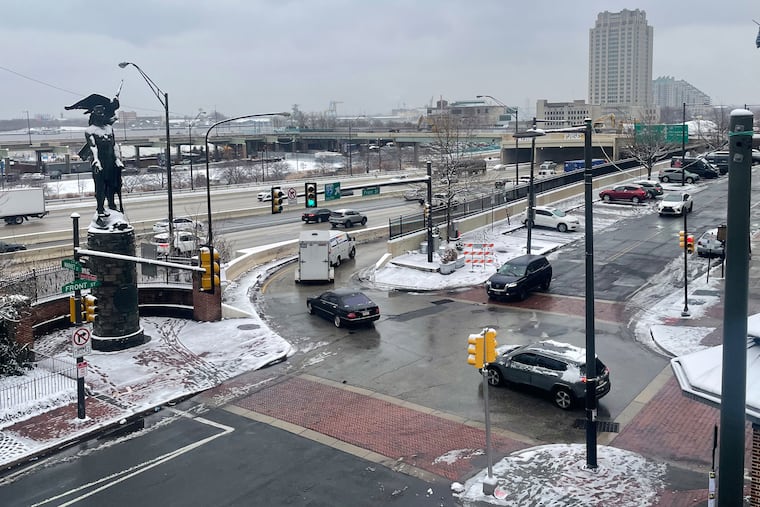Proposal to move Philly’s Chief Tamanend statue stalls as tribe objects
The goal is to place the Chief Tamanend statue in a new square planned for Second and Market Streets.

The statue depicting a likeness of Chief Tamanend, the Lenape leader who signed a peace treaty with William Penn, is pedestaled at a gaping I-95 entrance ramp in the Old City neighborhood of Philadelphia.
Motorists zip by the statue at Front and Market Streets without a glance as they cruise out of town. Pedestrians risk oncoming traffic just to get a glimpse of the bronze figure.
But a proposal to move the statue to a place of prominence in a new Tamanend Square being planned as part of a revamping of Market Street in Old City appears stalled as at least one federally designated tribe objects.
The objection by the tribe takes on new relevance in light of the recent dustup involving now-scrapped plans to move the statue of William Penn from Welcome Park, which is located a few blocks away and part of Independence National Historical Park. The National Park Service is proposing to rehabilitate Welcome Park and include Native American history.
» READ MORE: William Penn statue will not be removed from Welcome Park, says National Park Service in sudden reversal
‘Tired of moving’
“After 300-plus years of forced removal, it just seems as if it’s just another metaphoric forced removal from an area of our own land,” said Jeremy Johnson, cultural education director of the federally recognized Delaware Tribe of Indians in Bartlesville, Okla.
The tribe viewed treaties and land sales that the Lenape signed with European colonists more like leases, unaware that land was something to be bought or sold. Eventually, the Lenape had no land left and moved west, eventually settling in Oklahoma.
“We’re tired of moving,” Johnson said. “We’ve been told multiple times in our history that we’re in the way of progress.”
The statue, by Raymond Sandoval and erected in 1995, depicts Tamanend standing on a turtle, which symbolizes his clan and Mother Earth. An eagle near his shoulder represents a messenger of the Great Spirit.
What is the plan for the statue?
The proposal to move the Chief Tamanend statue is an outgrowth of a plan known as Vision2026, which calls for the transformation of Market Street in Old City by 2026, the Semiquincentennial, or 250th birthday of America. The plan includes reducing motor vehicle lanes and installing a bike lane in each direction.
The Vision2026 plan, which encompasses the central part of Old City, includes a new Tamanend Square at Second and Market Streets, near Christ Church and the Market-Frankford subway station.
The pedestrian-friendly Tamanend Square is planned at the already bustling intersection and would serve as the new home for the Chief Tamanend statue while connecting with an existing park and the redesigned Market Street corridor. The final design for the square is expected this year with construction scheduled for completion in 2025. Under the proposal, the statue would be moved to the intersection of Second and Market Streets.
Officials involved in the Market Street transformation project have been working with various Native American tribes on the proposal. However, those officials want to reach a consensus with stakeholders.
“We aspire to have the statue moved from its current location,” said Bill Marrazzo, chair of the Independence Historical Trust, a key fundraiser for Independence National Historical Park. Marrazzo is also the CEO and president of WHYY, Philadelphia’s public radio station. The trust is also raising money for the plaza.
Marrazzo said the new location would allow the statue to “more easily be appreciated and become sort of a monumental piece for educating people about Chief Tamanend’s role in the creation of the Commonwealth of Pennsylvania.”
He said that Sandoval, the sculptor, supported the move.
“It’s a matter of getting all of the stakeholders to concur,” Marrazzo said.
No consensus
Marrazzo said that, as of yet, there is no consensus among Indigenous groups considered stakeholders. Those known to be in the conversation include the federally recognized Delaware Tribe of Indians, as well as the federally recognized Delaware Nation, based in Anadarko, Okla. Discussions also include the New Jersey state-recognized Nanticoke Lenni-Lenape based in Bridgeton, Cumberland County.
Katelyn Lucas, the Delaware Nation’s tribal historic preservation officer, said her office has been consulting on the project. But the Delaware Nation, she said, considers the discussions private and “has determined that they do not want to speak to reporters on this issue.”
The Nanticoke Lenni-Lenape did not return several e-mails seeking comment. On its website, the Nanticoke Lenni-Lenape say that most people think of the tribes based in the Midwest, but fail to realize that tribal families remained behind in New Jersey, and fearing racism, isolated themselves away from “unwanted attention from outsiders.” That changed amid the civil rights era of the 1960s and 1970s when they began to publicly advocate for themselves.
“Our tribe’s history and families are historically well documented, although not well known among the public,” the website says. “We are working to correct this.”
Johnson, of the Delaware Tribe of Indians, said he was appreciative of Philadelphia’s efforts to work with the tribe.
Johnson said the Chief Tamanend statue was positioned to face the statue of William Penn atop Philadelphia’s City Hall at Broad and Market Streets, a little more than one mile west. But its location also symbolizes the Lenape’s attachment to the river, Johnson said.
“It is symbolic of how we lived there on the river and how it was the lifeblood of our communities,” Johnson said.